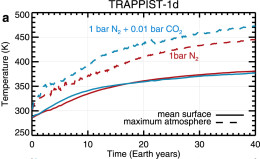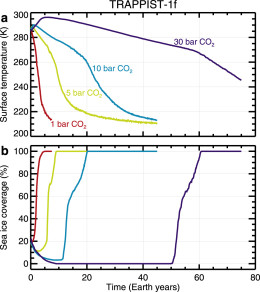The recent discovery of seven Earth-sized, terrestrial planets around an M dwarf star was met with excitement and optimism. But how habitable are these planets actually likely to be? A recent study of these planets’ likely climates may provide an answer to this question.
An Optimistic Outlook
In February of this year, the TRAPPIST-1 system was announced: seven roughly Earth-sized, transiting, terrestrial planets all orbiting their host ultracool dwarf star within a distance the size of Mercury’s orbit. Three of the planets were initially declared to be in the star’s habitable zone — and scientists speculated that even those outside the habitable zone could potentially still harbor liquid water — making the system especially exciting.

In Wolf’s simulations, the surface temperature (solid lines) of TRAPPIST-1d grows to more than 380K in just 40 years. [Adapted from Wolf 2017]
Finding Realistic Temperatures
But there’s a catch: equilibrium temperatures are not actual measurements of the planet’s surface temperature, they’re just very rudimentary estimates based on how much light the planet receives. To get a better estimate of the real temperature of the planet — and therefore assess its habitability — you need advanced climate modeling of the planet that include factors like the greenhouse effect and planetary albedo.

In Wolf’s simulations, the surface temperature of TRAPPIST-1f plummets rapidly even when modeled with dense carbon dioxide atmosphere (purple line). The bottom panel shows the corresponding rapid growth of sea-ice on the surface oceans for the different atmospheric models. [Wolf 2017]
Runaway and Snowball Planets
Wolf’s climate model indicates that the closest-in of the three planets, planet d, would undergo thermal runaway even in the best case scenario. In just 40 years of the simulation, the planet’s surface temperature exceeds 380K, suggesting it couldn’t continue to sustain liquid water. Wolf argues that planet d and the two planets interior to it, b and c, all lie inside of the traditional liquid water habitable zone — they are hot, dry, and uninhabitable.
Next, Wolf models the outermost of the three center planets, planet f. Even when planet f is modeled with a dense carbon dioxide atmosphere, it can’t avoid its fate of becoming completely ice-covered within roughly 60 years. Wolf concludes that planets f, g and h all lie outside of the traditional habitable zone defined by the maximum carbon dioxide greenhouse limit.

Equilibrium solutions for TRAPPIST-1e with various atmospheric conditions. Top panel: mean surface temperature. Middle panel: sea-ice coverage. Bottom panel: habitable surface area. [Wolf 2017]
Goldilocks?
Lastly, Wolf turns to planet e, the central planet in the system. This planet, he finds, is the most viable candidate for a robustly habitable world. The simulations show that planet e can maintain habitable surface conditions for a variety of atmospheric compositions.
While astrobiologists eyeing TRAPPIST-1 may be disappointed that at second glance the planets are not quite as inhabitable as they first seemed, it is promising to see that the habitability of the central planet holds up reasonably well to some more realistic testing. Either way, future examinations of all seven of these planets should help us learn more about terrestrial, Earth-sized planets.
Citation
Eric T. Wolf 2017 ApJL 839 L1. doi:10.3847/2041-8213/aa693a

1 Comment
Pingback: April 14, 2017 | Colorado Space News